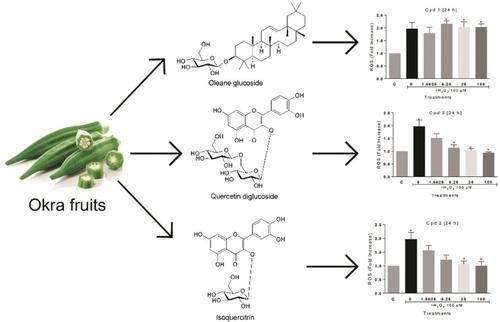当前位置:
X-MOL 学术
›
Chem. Biodivers.
›
论文详情
Our official English website, www.x-mol.net, welcomes your
feedback! (Note: you will need to create a separate account there.)
Isolation and Characterisation of Two Quercetin Glycosides with Potent Anti‐Reactive Oxygen Species (ROS) Activity and an Olean‐12‐en Triterpene Glycoside from the Fruit of Abelmoschus esculentus (Malvaceae Juss.)
Chemistry & Biodiversity ( IF 2.3 ) Pub Date : 2021-01-01 , DOI: 10.1002/cbdv.202000670 Bamigboye J Taiwo 1, 2 , Temidayo D Popoola 3 , Fanie R van Heerden 2 , Amos A Fatokun 3
Chemistry & Biodiversity ( IF 2.3 ) Pub Date : 2021-01-01 , DOI: 10.1002/cbdv.202000670 Bamigboye J Taiwo 1, 2 , Temidayo D Popoola 3 , Fanie R van Heerden 2 , Amos A Fatokun 3
Affiliation

|
Abelmoschus esculentus (Okra) is used in the traditional treatment of cancer, hyperlipidaemia and hyperglycaemia. We, therefore, investigated its composition and potential cytotoxic or antioxidant properties that might underlie its phytotherapeutic applications. Its methanolic fruit extract yielded compounds 1, 2 and 3, identified through NMR, UV and MS analyses as olean‐12‐en‐3‐O‐β‐d‐glucopyranoside, isoquercitrin (quercetin glucoside) and 5,7,3′,4′‐tetrahydroxy‐flavonol‐3‐O‐[β‐d‐glucopyranosyl‐(1→6)]‐β‐d‐glucopyranoside (quercetin diglucoside), respectively. Following 48 h exposure, oleanene glucoside was mildly toxic to the HeLa and the MRC5‐SV2 cancer cells, isoquercitrin was not toxic except at 100 μg/ml in HeLa, and quercetin diglucoside elicited no toxicity. In a 2′,7′‐dichlorofluorescein diacetate (DCFDA) assay of intracellular levels of reactive oxygen species (ROS), hydrogen peroxide increased ROS levels, an effect not affected by oleanene glucoside but protected against by isoquercitrin and quercetin diglucoside, with IC50 values, respectively, of 2.7±0.5 μg/ml and 1.9±0.2 μg/ml (3 h post‐treatment) and 2.0±0.8 μg/ml and 1.5±0.4 μg/ml (24 h post‐treatment.) This is the first report of this oleanene skeleton triterpenoid in the plant. The work provides some insight into why the plant is included in remedies for cancers, cardiovascular complications and diabetes, and reveals it as a potential source of novel therapeutics.
中文翻译:

从 Abelmoschus esculentus (Malvaceae Juss.) 果实中分离和表征两种具有强抗活性氧 (ROS) 活性的槲皮素糖苷和一种 Olean-12-en 三萜糖苷
Abelmoschus esculentus (Okra) 用于癌症、高脂血症和高血糖症的传统治疗。因此,我们研究了其组成和潜在的细胞毒性或抗氧化特性,这可能是其植物治疗应用的基础。其甲醇果实提取物产生化合物 1、2 和 3,通过 NMR、UV 和 MS 分析鉴定为 olean-12-en-3-O-β-d-吡喃葡萄糖苷、异槲皮苷(槲皮素葡萄糖苷)和 5,7,3', 4'-四羟基-黄酮醇-3-O-[β-d-吡喃葡萄糖基-(1→6)]-β-d-吡喃葡萄糖苷(槲皮素二葡萄糖苷)。暴露 48 小时后,齐墩果烯葡萄糖苷对 HeLa 和 MRC5-SV2 癌细胞有轻度毒性,异槲皮苷在 HeLa 中除 100 μg/ml 外无毒性,槲皮素二葡萄糖苷无毒性。在 2' 中,7'-二氯荧光素二乙酸酯 (DCFDA) 测定细胞内活性氧 (ROS) 水平,过氧化氢增加了 ROS 水平,这种作用不受齐墩果苷的影响,但受到异槲皮苷和槲皮素二糖苷的保护,IC50 值分别为 2.7 ±0.5 μg/ml 和 1.9±0.2 μg/ml(处理后 3 小时)和 2.0±0.8 μg/ml 和 1.5±0.4 μg/ml(处理后 24 小时)。这是这种齐墩果骨架的首次报道植物中的三萜。这项工作提供了一些关于为什么该植物被包含在癌症、心血管并发症和糖尿病治疗中的见解,并揭示了它是新疗法的潜在来源。IC50 值分别为 2.7±0.5 μg/ml 和 1.9±0.2 μg/ml(处理后 3 小时)和 2.0±0.8 μg/ml 和 1.5±0.4 μg/ml(处理后 24 小时)。是植物中这种齐墩果骨架三萜类化合物的首次报道。这项工作提供了一些关于为什么该植物被包含在癌症、心血管并发症和糖尿病治疗中的见解,并揭示了它是新疗法的潜在来源。IC50 值分别为 2.7±0.5 μg/ml 和 1.9±0.2 μg/ml(处理后 3 小时)和 2.0±0.8 μg/ml 和 1.5±0.4 μg/ml(处理后 24 小时)。是植物中这种齐墩果骨架三萜类化合物的首次报道。这项工作提供了一些关于为什么该植物被包含在癌症、心血管并发症和糖尿病治疗中的见解,并揭示了它是新疗法的潜在来源。
更新日期:2021-01-01
中文翻译:

从 Abelmoschus esculentus (Malvaceae Juss.) 果实中分离和表征两种具有强抗活性氧 (ROS) 活性的槲皮素糖苷和一种 Olean-12-en 三萜糖苷
Abelmoschus esculentus (Okra) 用于癌症、高脂血症和高血糖症的传统治疗。因此,我们研究了其组成和潜在的细胞毒性或抗氧化特性,这可能是其植物治疗应用的基础。其甲醇果实提取物产生化合物 1、2 和 3,通过 NMR、UV 和 MS 分析鉴定为 olean-12-en-3-O-β-d-吡喃葡萄糖苷、异槲皮苷(槲皮素葡萄糖苷)和 5,7,3', 4'-四羟基-黄酮醇-3-O-[β-d-吡喃葡萄糖基-(1→6)]-β-d-吡喃葡萄糖苷(槲皮素二葡萄糖苷)。暴露 48 小时后,齐墩果烯葡萄糖苷对 HeLa 和 MRC5-SV2 癌细胞有轻度毒性,异槲皮苷在 HeLa 中除 100 μg/ml 外无毒性,槲皮素二葡萄糖苷无毒性。在 2' 中,7'-二氯荧光素二乙酸酯 (DCFDA) 测定细胞内活性氧 (ROS) 水平,过氧化氢增加了 ROS 水平,这种作用不受齐墩果苷的影响,但受到异槲皮苷和槲皮素二糖苷的保护,IC50 值分别为 2.7 ±0.5 μg/ml 和 1.9±0.2 μg/ml(处理后 3 小时)和 2.0±0.8 μg/ml 和 1.5±0.4 μg/ml(处理后 24 小时)。这是这种齐墩果骨架的首次报道植物中的三萜。这项工作提供了一些关于为什么该植物被包含在癌症、心血管并发症和糖尿病治疗中的见解,并揭示了它是新疗法的潜在来源。IC50 值分别为 2.7±0.5 μg/ml 和 1.9±0.2 μg/ml(处理后 3 小时)和 2.0±0.8 μg/ml 和 1.5±0.4 μg/ml(处理后 24 小时)。是植物中这种齐墩果骨架三萜类化合物的首次报道。这项工作提供了一些关于为什么该植物被包含在癌症、心血管并发症和糖尿病治疗中的见解,并揭示了它是新疗法的潜在来源。IC50 值分别为 2.7±0.5 μg/ml 和 1.9±0.2 μg/ml(处理后 3 小时)和 2.0±0.8 μg/ml 和 1.5±0.4 μg/ml(处理后 24 小时)。是植物中这种齐墩果骨架三萜类化合物的首次报道。这项工作提供了一些关于为什么该植物被包含在癌症、心血管并发症和糖尿病治疗中的见解,并揭示了它是新疗法的潜在来源。










































 京公网安备 11010802027423号
京公网安备 11010802027423号